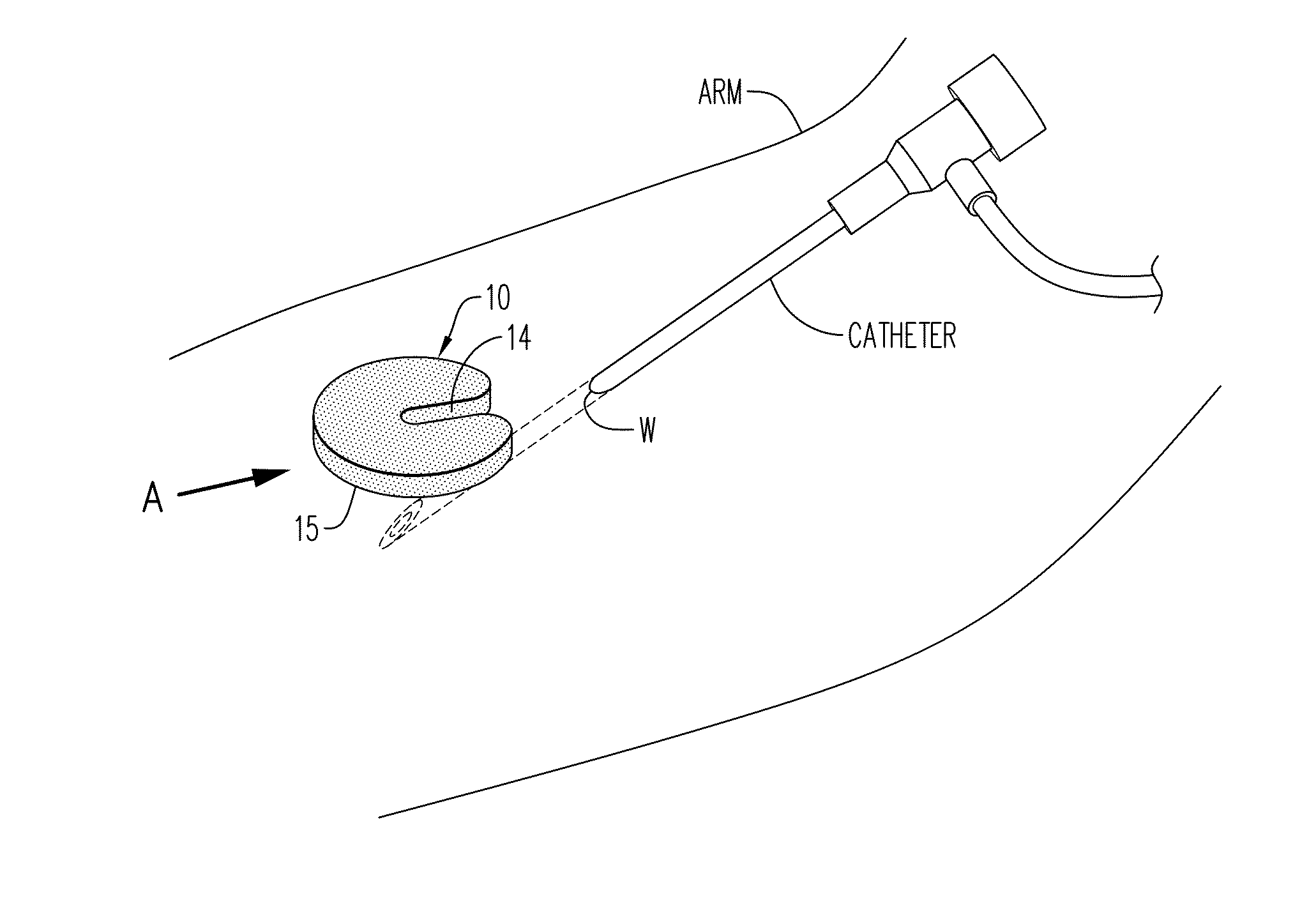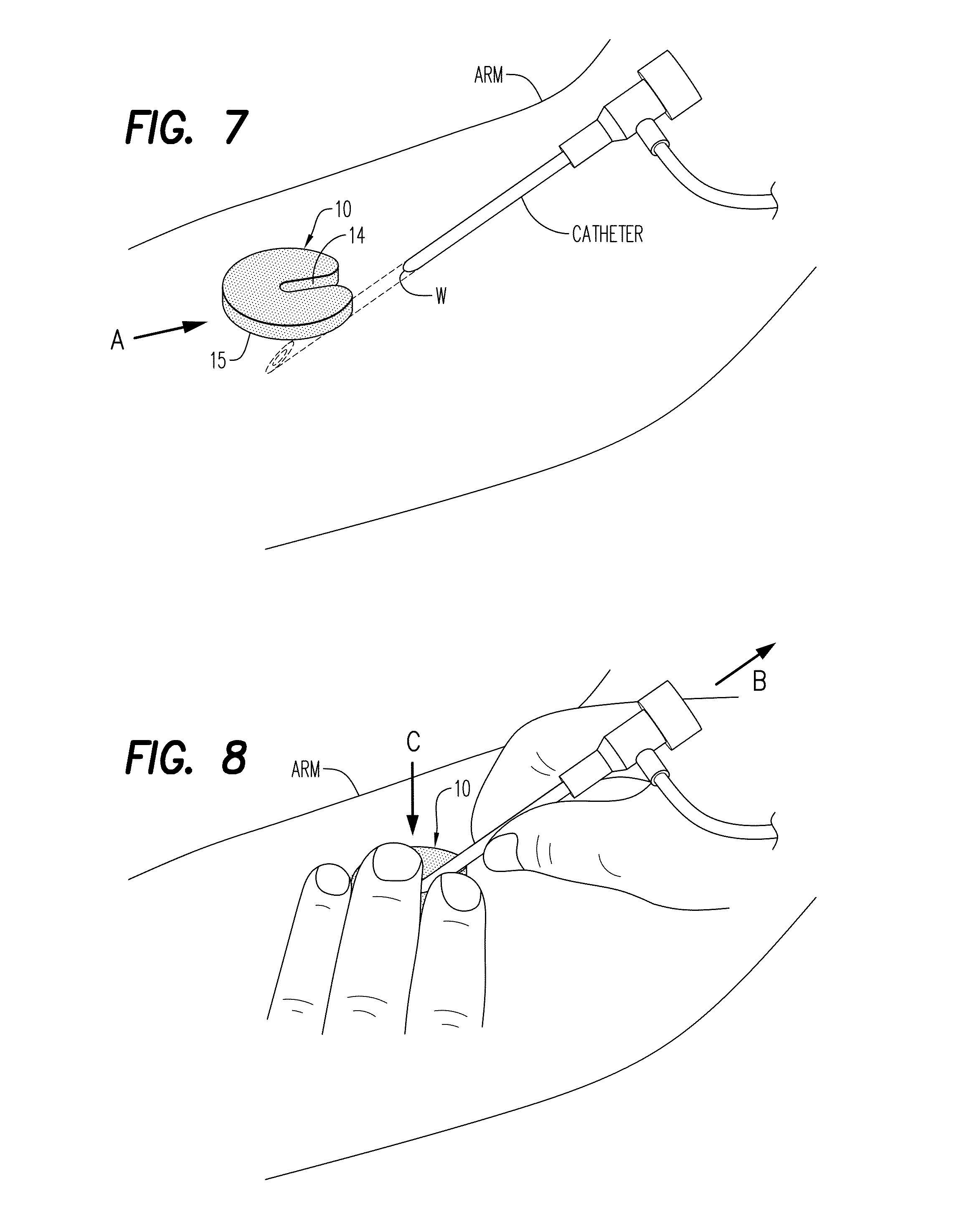Hemostatic device and method
a technology of hemostatic devices and methods, applied in the field of hemostatic products, can solve the problems of other limitations of the related art, and achieve the effects of reducing surface area, improving delivery and control of application, and slowing down the effect of action
- Summary
- Abstract
- Description
- Claims
- Application Information
AI Technical Summary
Benefits of technology
Problems solved by technology
Method used
Image
Examples
embodiment details
[0196]Referring now to the drawings, and firstly to FIGS. 1 to 3, one embodiment of the invention is there shown generally at numeral 10 and includes a circular body 12 formed of hemostatic material, the content, physical properties of which will be described herebelow. The body 12, sometimes referred to as a wafer body, a disc, or a tablet, includes an elongated cannula access slot 14 formed radially inwardly from the perimeter to the center of the body 12, terminating at a slot proximal end 16. To facilitate installation around an I.V. cannula as shown in FIGS. 7 and 8, radiused slot entrance corner 18 forming the inlet end of the cannula access slot 14 are provided.
[0197]As seen in FIG. 7, the hemostatic device 10 is positionable in the direction of arrow A so that the catheter, needle or cannula access slot 14 slides around the catheter and is positioned against the skin of the arm at the wound site W. The skin contact surface 15 of the hemostatic device 10 is then pressed again...
example 1
Formation Pressure
[0216]The hemostatic composition for the powder is preferably 1:7 weight mixture of ferrate:hydrogen resin, although this ratio has a range of 1:3 to 1:12. The hydrogen resin is, preferably, the hydrogen form of the 2% crosslinked, sulfonated poly(styrene) resin. The hydrogen resin is available in whole insoluble beads in the range of 500 microns or can be ground into much finer fragments averaging in size from 80 microns to 200 microns. Device formation is based, in part, on the percent of resin fractured to whole beads. The crosslinked hydrogen ion exchange resin will not melt as temperature is increased nor will it cold flow with pressure. Therefore whole resin beads alone cannot be formed into a tablet with pressure.
[0217]As seen in FIG. 46, column 3, at 45k psi, whole beads will not bind together into a solid. As shown in column 3 in FIG. 46, mixtures of whole beads and fragments (61 to 89%:39 to 11%) will bind together. A sufficient percentage of fragments to...
example 2
Minimum Thickness
[0219]As seen in FIG. 47, the hemostatic powder preferably of 1:7 potassium ferrate: hydrogen resin, was made into solid bodies in tablet form using a lab press. Preliminary tablet formation testing of tablet thicknesses from about 0.5 mm to 30 mm established a minimum thickness of about 0.5 mm for compressing the hemostatic powder into a solid device. The photos in FIG. 47 indicate that at least 0.5 mm thickness is needed to create a complete usable tablet. The material was ground to <250 μm. However, changing the grind size may affect the minimum thickness of powder needed to create a complete tablet. Based on handling or usability, the thin (0.53 mm) 20 mm diameter tablet created with 45K psi (#3) had more integrity than did the thin tablet at 29K psi formation pressure. In Test #1, 29K psi was not sufficient to form a 0.426 mm thick tablet, but in Test #2, a fragile and unstable tablet having a thickness of 0.535 mm was formed.
[0220]Three tests were used for the...
PUM
| Property | Measurement | Unit |
|---|---|---|
| size | aaaaa | aaaaa |
| size | aaaaa | aaaaa |
| density | aaaaa | aaaaa |
Abstract
Description
Claims
Application Information
 Login to View More
Login to View More - R&D
- Intellectual Property
- Life Sciences
- Materials
- Tech Scout
- Unparalleled Data Quality
- Higher Quality Content
- 60% Fewer Hallucinations
Browse by: Latest US Patents, China's latest patents, Technical Efficacy Thesaurus, Application Domain, Technology Topic, Popular Technical Reports.
© 2025 PatSnap. All rights reserved.Legal|Privacy policy|Modern Slavery Act Transparency Statement|Sitemap|About US| Contact US: help@patsnap.com



